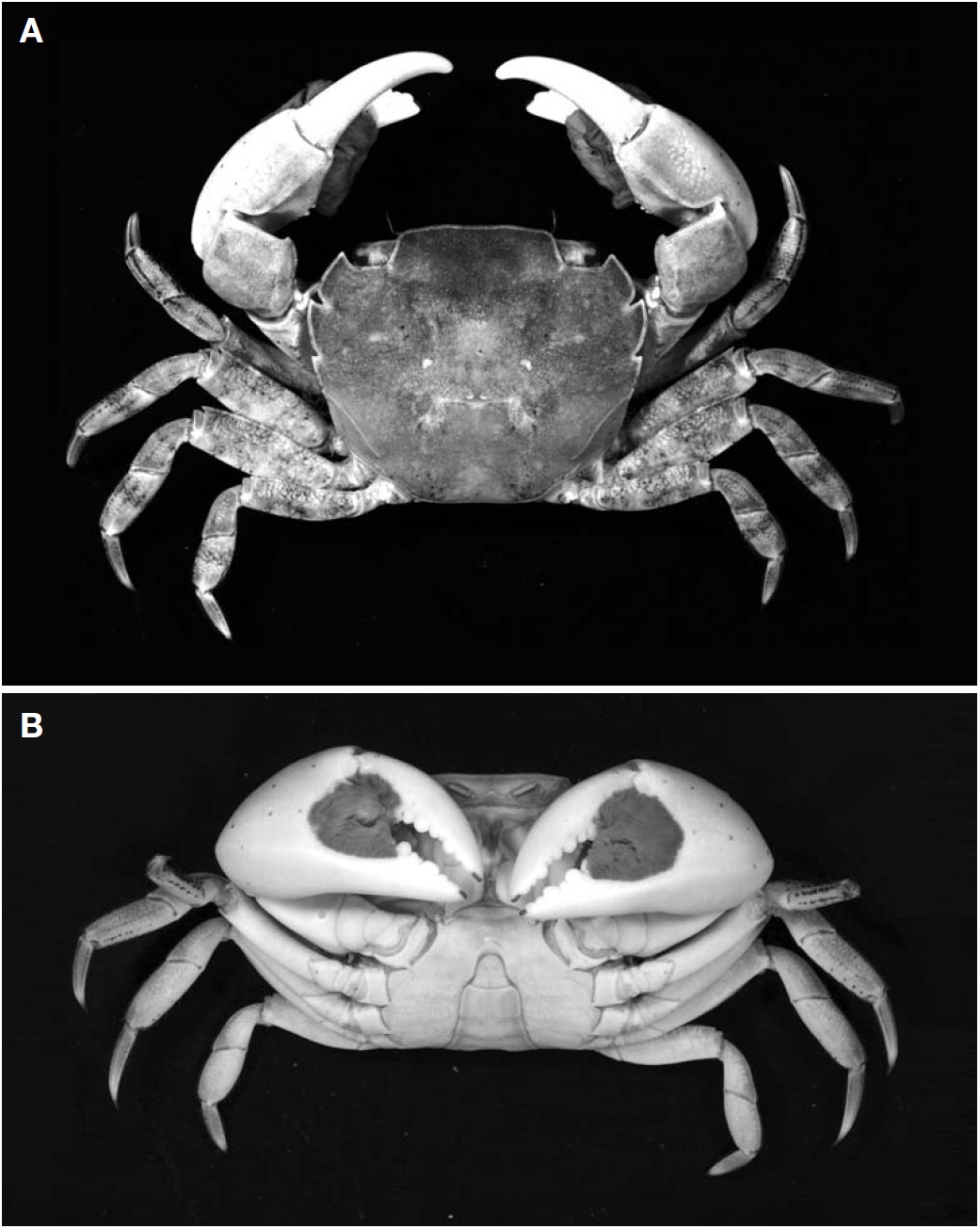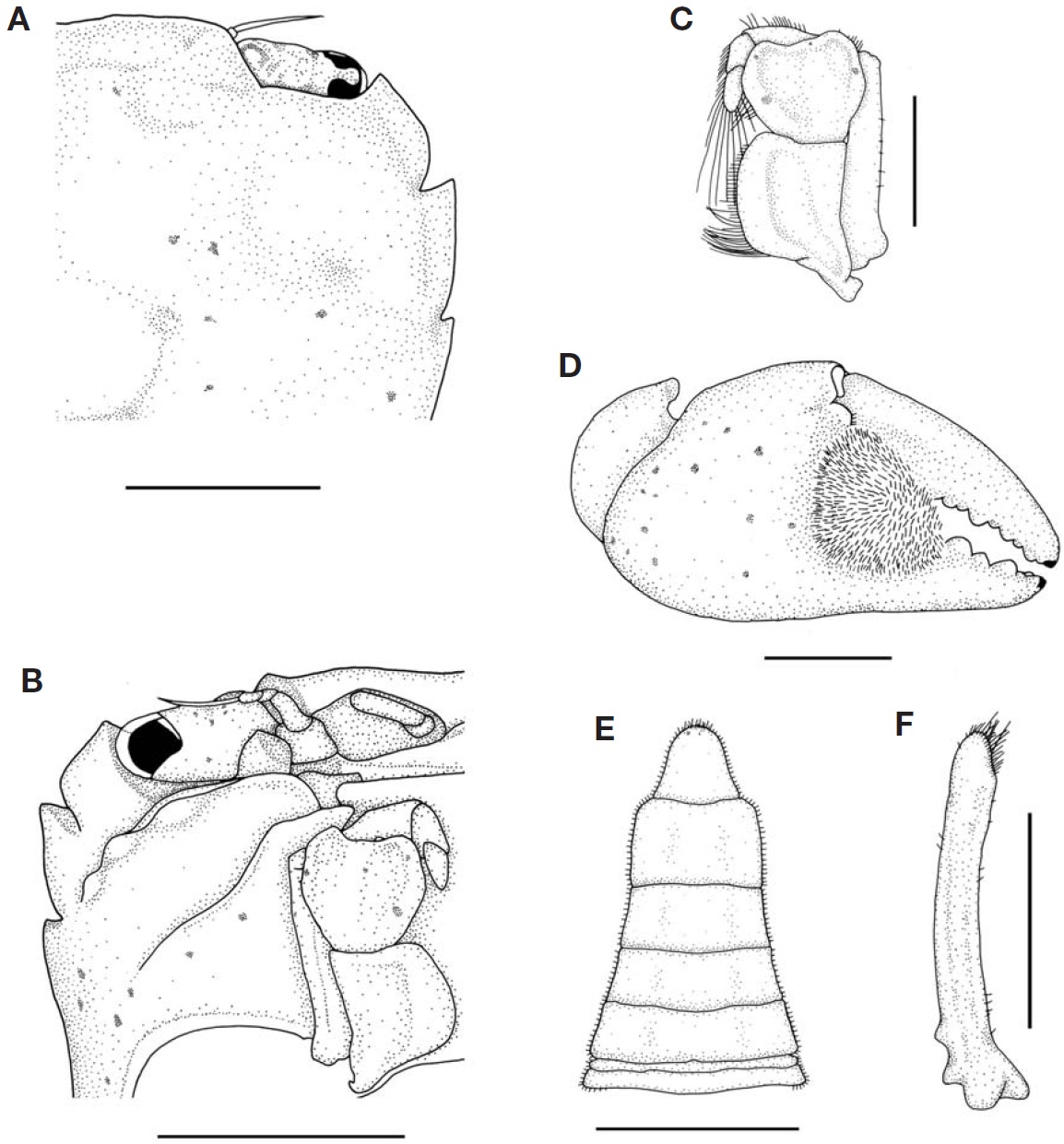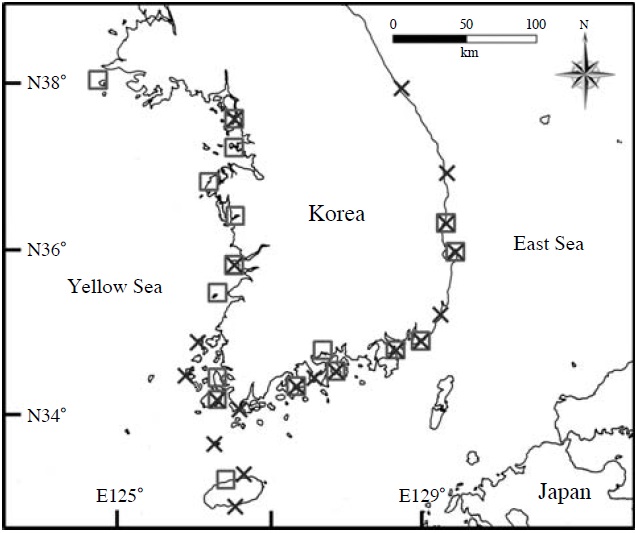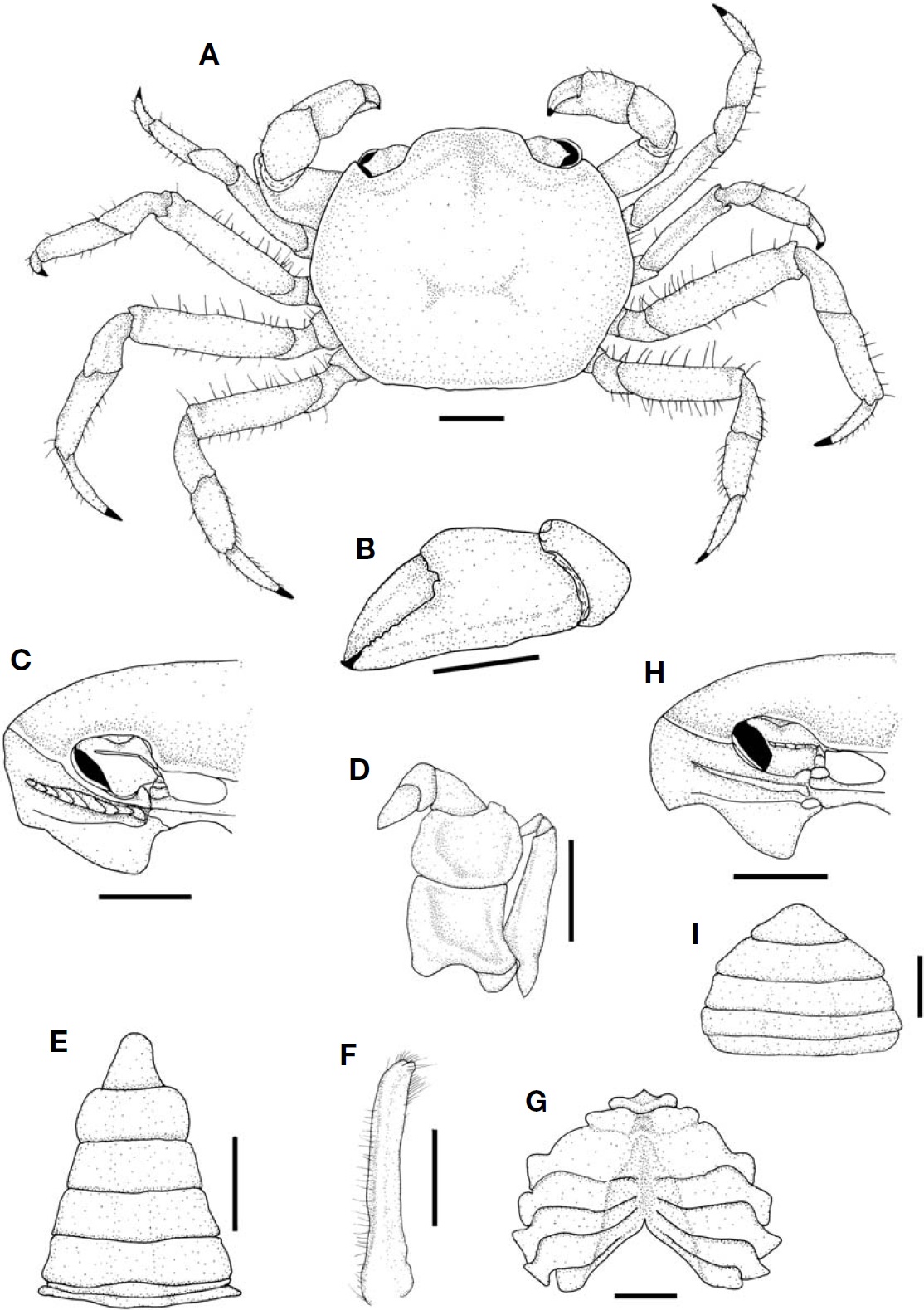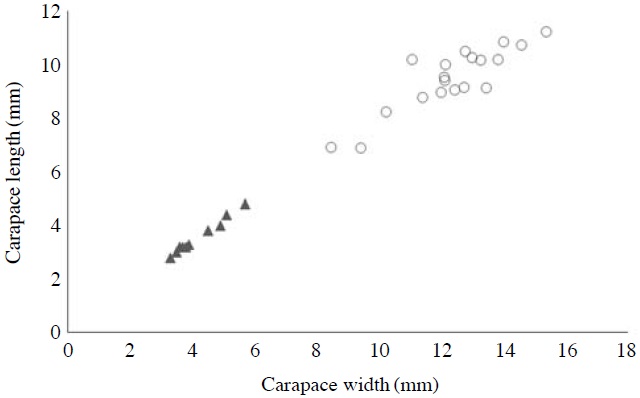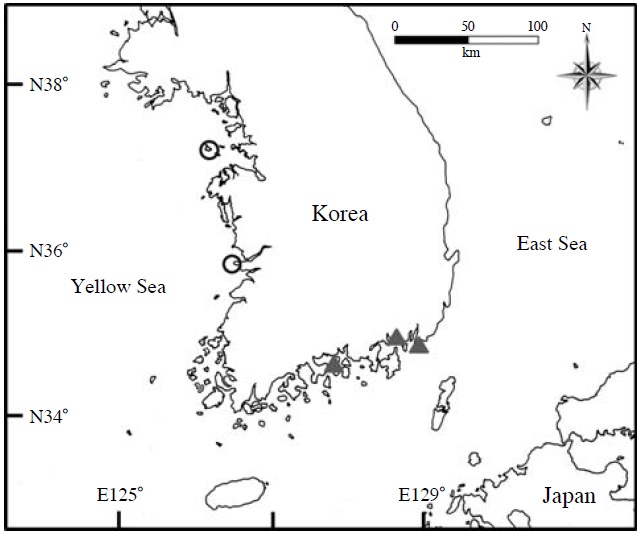



The members of the family Varunidae are familiar in the intertidal zone. They live in crevices and under stones on rocky shores or burrow into soft sediments. As a result of the ongoing inventory work on the Korean crabs deposited in the Laboratory of Systematics and Molecular Evolution, Seoul National University, revealed that two crabs,
Three species of the genus
The specimens examined in this study were preserved in 70% ethyl alcohol. All drawings were prepared using camera lucida on a Nikon SMZ800 (Nikon, Tokyo, Japan). All characters were measured using a digital slide caliper Mitutoyo CD- 6CSX (Mitutoyo, Kawasaki, Japan) to the nearest 0.1 mm. The abbreviations CW, CL, and G1 refer to the carapace width, carapace length and first gonopod of the male, respectively. The width of the carapace was measured across the widest breadth including the longest anterolateral tooth on each side. The length of the carapace was measured across the middle of the carapace from the tip of the longest lobe of the frontal border to the posterior border, including any tubercles along the posterior border. The specimens examined in the present study are deposited in the Marine Arthropod Depository Bank of Korea (MADBK), Seoul National University.
Order Decapoda Latreille, 1802
Superfamily Grapsoidea Macleay, 1838
Family Varunidae H. Milne Edwards, 1853
Genus Hemigrapsus Dana, 1851
1*
Material examined. Korea: 31♂♂, 28 ♀♀, Incheon, 6 Jun 1954; 2♂♂, 66♀♀, Chungcheongnam-do: Boryeongsi, Daecheon-dong, 25 Jul 1957; 6♂♂, 1♀, Taean-gun, Anmyeon- eup, 12 May 1964; 105♂♂, Incheon, 14 Apr 1968; 1♂, Jeollanam-do: Yeosu-si, Dolsan-eup, 14 Jun 1969; 2♂♂, Jeju-do: Jeju-si, Iho-dong, 11 Aug 1969; 12♂♂, 10♀♀, Incheon, 25 Apr 1970; 42♂♂, 10♀♀, Incheon, 9 May 1971; 3♂♂, 1♀, Chungcheongnam-do: Seocheon-gun, Biin-myeon, 20 Jul 1971; 3♂♂, 2♀♀, Seocheon-gun, Biinmyeon, 23 Jul 1971; 2♂♂, 3♀♀, Jeollabuk-do: Buan-gun, Wido-myeon, 13 Apr 1972; 2♂♂, Incheon, 21 Jul 1973; 14♂♂, Busan: Haeundae-gu, Jung-dong, 16 Jul 1974; 3♂♂, Jeollanam-do: Jindo-gun, 3 Aug 1974; 10♂♂, 4♀♀, Jeollabuk- do: Buan-gun, 8 May 1978; 3♂♂, Busan: Gangseo-gu, Songjeong-dong, 24 May 1978; 1♂, Gyeongsangnam-do: Namhae-gun, Sangju-myeon, Sangju-ri, 8 Oct 1978; 1♂, 3♀♀, Gimhae-si, Jillye-myeon, Songjeong-ri, 31 Oct 1978; 17♂♂, 14♀♀, Jeollabuk-do: Gunsan-si, Okdo-myeon, 25 Jul 1980; 2♂♂, Gyeongsangbuk-do: Yeongdeok-gun, Ganggu- myeon, Opo-ri, 12 Aug 1982; 4♂♂, 4♀♀, Busan, Sahagu, Dadae-dong, 27 Aug 1984; 4♂♂, Jeollanam-do: Jindogun, 25 Jul 1994; 28♂♂, 15♀♀, Chungcheongnam-do: Taean-gun, Anmyeon-eup, 26 Jun 2000; 11♂♂, 5♀♀, Taean-gun, Anmyeon-eup, 27 Jul 2000; 1♂, Seosan-si, Daesan- eup, Ungdo-ri, 30 Jun 2000; 2♂♂, 1♀, Taean-gun, Anmyeon-eup, 1 Jul 2000; 3♂♂, 4♀♀, Jeollanam-do: Haenam- gun, Hwawon-myeon, Jugwang-ri, 27 Aug 2000; 3♂♂, 2♀♀, Gyeonggi-do: Hwaseong-si, Ujeong-eup, Hogok-ri, 29 Sep 2000; 1♂, 1♀, Hwaseong-si, Ujeong-eup, Hogok-ri, 30 Sep 2000; 2♂♂, 8♀♀, Incheon, 14 Oct 2000; 6♂♂, 5♀♀, Jeollanam-do: Goheung-gun, Bongnae-myeon, 20 Oct 2001; 4♂♂, Chungcheongnam-do: Seosan-si, Daesaneup, Ungdo-ri, 22 Jun 2002; 1♂, Jeollabuk-do: Buan-gun, 27 Apr 2003; 2♂♂, 2♀♀, Buan-gun, 22 Aug 2003; 16♂♂, 10♀♀, Buan-gun, 23 Aug 2003; 96♂♂, 63♀♀, Incheon, 24 Jan 2006; 21♂♂, Gyeongsangnam-do: Goseong-gun, Donghae-myeon, Yongjeong-ri, 25 Apr 2009; 3♂♂, Masansi, Jinjeon-myeon, Imyeong-ri, 25 Apr 2009; 1♂, 1♀, Chungcheongnam- do: Seocheon-gun, Seo-myeon, Wolho-ri, 14 May 2009; 24♂♂, Gyeongsangbuk-do: Pohang-si, Nam-gu, Daebo-myeon, Daebo-ri, 10 Oct 2009; 21♂♂, 15♀♀, Jeollanam- do: Jindo-gun, 15 Jun 2011; 8 ♂♂, 6 ♀♀, Chungcheongnam- do: Taean-gun, Nam-myeon, Mongsan-ri, 17 Jun 2011.
Comparative materials.
Seogwipo-si, 17 Oct 2005; 13♂♂, 9♀♀, Seogwipo-si, 17 Oct 2005; 2♂♂, Jeju-si, Hangyeong-myeon, Sinchangri, 25 Oct 2005; 3♂♂, 1♀, Gujwa-eup, Hado-ri, 26 Oct 2005; 24♂♂, 5♀♀, Gujwa-eup, Gimnyeong-ri, 27 Oct 2005; 2♂♂, 1♀, Seogwipo-si, 27 Oct 2005; 5♂♂, Gyeongsangnam- do: Geoje-si, Hacheong-myeon, 11 May 2006; 19♂♂, 17♀♀, Jeju-do: Seogwipo-si, 13 Oct 2006; 4♂♂, 2♀♀, Jeju-si, Udo-myeon, 14 Oct 2006; 33♂♂, 5♀♀, Seogwipo-si, 15 Oct 2006; 1♂, 1♀, Gujwa-eup, Hado-ri, 15 Oct 2006; 45♂♂, 29♀♀, Seogwipo-si, 17 Oct 2006; 54♂♂, 22♀♀, Seogwipo-si, 28 May 2007; 7♂♂, 3♀♀, Gujwa-eup, Hado-ri, 28 May 2007; 3♂♂, Jeju-si, Aewoleup, 30 May 2007; 3♂♂, 3 ♀♀, Seogwipo-si, 1 Jun 2007; 33♂♂, 54♀♀, Gujwa-eup, Hado-ri, 12 Jul 2007; 11♂♂, 2♀♀, Gyeongsangnam-do: Ulsan, Ulju-gun, Seosaengmyeon, Jinha-ri, 11 Apr 2009; 1♂, Jeollanam-do: Yeonggwang-gun,
Nagwol-myeon, 16 Apr 2009; 44♂♂, Gyeongsangnam- do: Goseong-gun, Donghae-myeon, Yongjeong-ri, 25 Apr 2009; 20♂♂, Masan-si, Jinjeon-myeon, Imyeong-ri, 25 Apr 2009; 7♂♂, Jeollanam-do: Jindo-gun, 17 Jun 2009; 106♂♂, Gyeongsangbuk-do: Pohang-si, Nam-gu, Daebomyeon, Daebo-ri, 10 Oct 2009; 76♂♂, 13♀♀, Jeollanamdo: Wando-gun, Wando-eup, Mangseok-ri, 20 Jun 2010.
Description. Carapace (Figs. 1A, 2A) quadrilateral, about 1.2 times as broad as long, width narrow posteriorly. Cardiac region, gastric region and branchial region divided by distinct H-formed groove. Surface smooth and hairless. Lateral border bearing 3 distinct teeth in both directions, decreasing in size posteriorly. Supraorbital border deep and slightly angulated. Third maxillipeds (Fig. 2B, C) broad. Ischium quadrilateral, inner border circular. Margins of merus and ischium slightly convex.
Male chelipeds (Figs. 1,2D) robust and smooth, each one almost same size; comparatively large and inflated. Basal of

The number of individuals and occurrence rates of Hemigrapsus takanoi and H. penicillatus in each coastal region of Korea
fixed finger having well developed bundle of soft setae, diameter of setal patches about 0.5 times as broad as dactylus length. Dactylus slightly curved to ventral, cutting edges with several well developed granulated teeth.
Ambulatory legs (Fig. 1) flatten. Dactylus, propodus and carpus having several rows of setae. Meri of first-third pereopods bearing single distal spine on extensor margin.
Male abdomen (Fig. 2E) consisting of seven plates, lateral limits divergent posteriorly, each lateral and distal border with short setae. Telson triangular.
G1 (Fig. 2F) stout, trigonal, straight, almost equal width; external part having dense setae.
Habitat. Live under boulders in intertidal zone.
Distribution. Japan, France, Spain, Belgium, Netherlands, Germany, and Korea (this study).
Remarks.
We investigated the distribution of these two species in the Korean peninsula.
Genus Sestrostoma Davie and Ng, 2007
1*
Material examined. Korea: 11♂♂ (CW 3.3-5.7 mm, CL
2.8-4.8 mm), 10♀♀ (CW 3.8-5.1 mm, CL 3.2-4.4 mm), Gyeongsangnam-do: Changwon-si, Daecheon-dong, 13 Jun 1999; 1♀, Busan, Dadae-dong, 28 Apr 1985; 1♂, 5♀♀, Changwon-si, Daecheon-dong, 23 Feb 1997; 1♀, Namhaegun, Seo-myeon, 1 Jul 1998; 8♂♂, 1♀, Namhae-gun, Samdong- myeon, 2 Jul 1998; 1♂, Namhae-gun, Gohyeon-myeon, 29 Jul 1999.
Comparative materials.
Description. Carapace (Fig. 4A) quadrilateral, more or less angulated in median part of each lateral border, being slightly wider than long; 0.8-0.9 times as long as wide. Dorsum moderately and evenly convex in both directions. Surface naked and glabrous, but minutely and irregularly punctate under binocular microscope. Lateral and posterior borders
narrowly rimmed; posterior border straight and only slightly narrower than frontal width. Front almost truncated only with dorsal obsolete depression in middle, being fringed with narrow rim; width 2.4-3.5 mm and just one fourth of carapace width. Suborbital ridge of male (Fig. 4C) composed of nine smooth and transverse tubercles, but those of female (Fig. 4H) forming one crest. Third maxillipeds (Fig. 4D) broad and completely closed in buccal cavern. Ischium and merus widely sculptured with large depression. Palp stout with extremely long apical hairs exceeding posterior end of ischium in natural position.
Chelipeds (Fig. 4B) minutely granulated, equal and large with inflated palms; outer surface of palm ornamented transverse ridge, with small tuft comparatively slender and fringed with sparse hairs. Tips of fingers meeting, or crossing only slightly.
Ambulatory legs (Fig. 4A) comparatively slender and fringed with sparse hairs; both borders of meri being covered with minute granules.
Anterior sternal plates (Fig. 4G) with distinct medial groove.
Male abdomen (Fig. 4E) narrowly triangular. Female abdomen (Fig. 4I) broadly triangular.
G1 (Fig. 4F) long, slender, with corneous process apically. Gonopore of female operculate, circular in shape.
Habitat. Mud and coarse sand, associated with thallassinid
Colour. Preserved specimens in 75% ethyl alcohol are cream or light brown colored.
Distribution. Japan (Onagawa Bay, Yamaguchi Bay), Hong Kong and south coast of Korea (this study).
Remarks. According to the original description of Takeda (1974), the suborbital crest as a stridulatory organ of
The carapace of
Korean name: 1*?д?????(???)
Korean name: 1*??????????(???)

